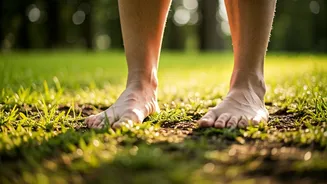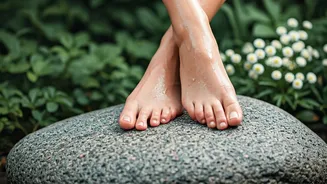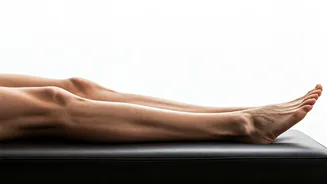The Barefoot Trend
Going barefoot, a practice once dismissed as unconventional, is gaining traction for its potential health benefits, with Meghan Markle among its proponents.
This trend taps into the concept of "grounding" or "earthing," the act of connecting your body with the earth's natural electrical energy. Advocates suggest that direct contact with the ground can offer various health perks. This connection, often achieved by walking barefoot on grass, sand, or earth, facilitates the transfer of electrons from the earth into the body. This influx of electrons is theorized to combat free radicals, which are unstable molecules that can damage cells and contribute to inflammation and chronic diseases. The trend underscores a renewed appreciation for simple, natural practices that can enhance well-being.
Science of Grounding
Scientific studies are beginning to explore the effects of grounding on the human body. Research suggests that grounding can reduce inflammation, as the influx of electrons from the earth may neutralize free radicals. Some studies have indicated that grounding can also improve sleep quality, reduce stress hormone levels, and even alleviate pain. The practice is thought to thin the blood, thereby improving blood flow and reducing the risk of cardiovascular issues. Furthermore, grounding may influence the nervous system, potentially promoting a sense of calm and well-being. Although more extensive research is needed to fully understand the effects of grounding, the existing studies offer promising insights into its potential benefits.
Health Benefits Explored
The potential health benefits associated with grounding are diverse. One primary benefit is the reduction of inflammation, a key factor in many chronic diseases. Grounding appears to help stabilize the electrical environment of the body, which can decrease pain and promote healing. Many individuals who practice grounding report improved sleep quality, which is crucial for overall health and well-being. Grounding can also positively impact stress levels, contributing to a calmer state of mind. Furthermore, it may have cardiovascular benefits by improving blood flow. Some preliminary evidence suggests grounding can also boost immune function, potentially reducing susceptibility to illness. The cumulative effects of grounding offer a holistic approach to improving health.
How to Ground
Incorporating grounding into your daily routine is relatively simple. The easiest way is to walk barefoot on natural surfaces like grass, sand, or soil. Even sitting or standing directly on the earth can provide grounding benefits. For those with limited access to outdoor spaces, grounding mats and sheets are available. These products simulate the grounding effect by connecting to the earth's electrical system through a grounding wire. Grounding can be practiced for short periods, such as 15-30 minutes daily, or for longer durations depending on personal preference and lifestyle. Consistency is key to experiencing the potential benefits of grounding, so integrating it regularly into your daily routine is essential to harness its full impact.
Considerations and Safety
While generally safe, grounding may not be suitable for everyone, and certain precautions should be considered. Individuals with implanted medical devices, such as pacemakers, should consult their doctor before engaging in grounding, as it may interfere with the device's function. When grounding outdoors, it’s advisable to be aware of your surroundings to prevent injuries from sharp objects or other hazards. If you are sensitive to changes in your body, start with shorter grounding sessions and gradually increase the duration. There is no standard dosage for grounding; the optimal amount varies from person to person. As with any wellness practice, listen to your body and discontinue grounding if you experience any adverse effects. Grounding should be seen as a complementary practice and not a replacement for medical treatment.











